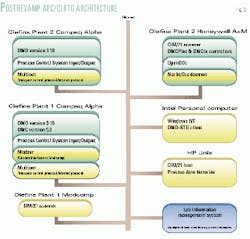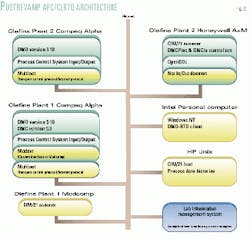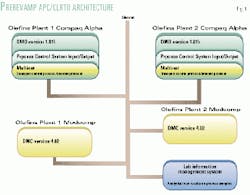Olefin plant revamp affects process control, real-time optimization
Paul D. Leggett, Elizabeth A. TeeterOlefins unit revamps impact existing advanced process control (APC) and closed-loop real-time optimization (CLRTO) systems. Although it is expensive to update these systems after a process-unit revamp, more-efficient unit performance usually justifies the update.
Equistar Chemicals LP,
Channelview, Tex.R. Mark Stout
Aspen Technology Inc.,
Houston
Equistar Chemicals LP, a joint venture among Lyondell Chemical Co., Millennium Chemicals Inc., and Occidental Petroleum Corp., recently updated the application systems in both of its Channelview, Tex., olefins units in response to process changes from a revamp.
During planned maintenance shutdowns in 1995-1996, Equistar expanded its two Channelview olefins plants' ethylene capacity by 7%, or 250 million lb/year.
In conjunction with the expansions, Equistar upgraded the regulatory control system in one of its plants from single-loop electronic controllers to a distributed control system (DCS). These changes affected the existing APC and CLRTO systems, which were revamped to handle the process changes.
After extended downtimes, when the plants are put back into production, the benefits of the existing APC and CLRTO systems are unavailable until the applications are updated to reflect the process and regulatory control changes.
Besides revenue loss, the lost-opportunity cost of not having the APC and CLRTO applications on-line includes loss of the less tangible operational improvement benefits such as operator convenience.
Control and optimization revamp projects face some technical issues that grassroots projects do not. APC and CLRTO revamps typically occur about every 5-6 years on the heels of a major turnaround because shutdowns outside of major maintenance outages are rarely justified.
This 5-6 year interval is a long time in terms of the life cycle of the technologies that are the bases for these applications. In addition to updating model structure, APC and CLRTO revamp projects often involve retrofitting new technology into the information systems infrastructure of the existing APC and CLRTO applications.
The scope of the revamp projects is often even more complex because these applications generally exchange data with other process information systems, such as laboratory information management (LIMS) and process data historians.
Scope of upgrades
The process scope of Equistar's recent Channelview olefins plant expansions debottlenecked the recovery sections of these plants. The project involved:
- Adding compressor capacity for charge gas, refrigeration systems, and methane.
- Expanding capacity of some distillation and wash columns.
- Adding necessary capacity in exchangers servicing affected compressors and towers.
- Modifying the chilling train to handle the increased compressor and column capacities.
The scope of the instrument system upgrade affected only one olefins plant's regulatory control system. The project replaced the system's electronic single-loop controllers connected to a Modcomp supervisory computer with a modern distributed control system.
Fig. 1 shows a diagram of architecture of the APC/CLRTO prior to the revamp. Fig. 2 shows the architecture after the revamp.
Process mods on APC
The most obvious impact of process changes on APC is on the models used within multivariable controllers. Some specific examples encountered in the revamp were:
- Modified column internals resulted in changes in the controlled-to-manipulated variable relationships. A given change in reflux or reboil rate no longer has the same effect on tower compositions once additional trays have been installed in the column or after the tray type has been changed.
- Modifications in heat-transfer equipment impact model responses. Heat-exchanger performance is not only affected by addition or removal of physical area, but also by transition to new heating or cooling media or improvement in heat transfer from cleaning fouled equipment. The impact on controller models is largest when these changes occur in overhead condensers and bottoms reboilers, but the effect of changes on secondary exchangers, such as feed preheaters, must not be overlooked.
- Changes in compressors, particularly in the refrigeration machines, affect many of the multivariable controller models for downstream recovery columns.
- Relocation of process measurements has an important, and often over-looked, effect on multivariable control model relationships. This relocation task is much more painful when the newly relocated process measurement is a controlled variable, rather than a manipulated variable. The step testing and identification required to establish the new models is much more extensive.
Another less visible impact of process changes on APC is the potential to add new variables to the multivariable controller structure as new handles are added to the process. New manipulated variables can be introduced to APC from the addition of new process equipment such as side reboilers and exchanger bypasses.
APC control changes
The upgrade of a regulatory control system has a much greater effect on the APC than that of the physical plant process. At the very least, engineers must rebuild the operator DCS displays for APC.
Beyond this basic requirement, however, is the possibility that the host computer platform and the revision of the APC software may both change. The upgrade in software revisions is typically a welcome change, as it often provides new functionality that can enhance the implementation of the APC.
As a case in point, when Equistar upgraded its electronic controllers to a state-of-the-art DCS, the APC software platform changed from DMC Version 4.02 to DMCPlus 1.04. The software upgrade introduced new subcontroller functionality, which allowed the engineers to change the configuration of the controller to encompass a much larger, integrated portion of the recovery section.
The host computer upgrade, on the other hand, is not always easy because it may mean that plant personnel are required to support a new operating system. For example, Equistar migrated from a VMS (Virtual Memory System) to a UNIX host.
Furthermore, if the APC software supplier does not already have an existing interface to the new DCS, the creation of custom interfaces between the APC host computer and DCS platforms may be an added requirement.
With the upgrade of the regulatory control system, more variables often become available for inclusion in an APC strategy. Examples of new variables include temperatures that were previously available only as local indicators and reboiler-level overrides that originally existed as local controllers.
The versatility and ease of configuration of a DCS also allows for added flexibility in modifying regulatory control schemes to enhance an APC application. For instance, some of Equistar's column level controllers were configured as straight level to valve controllers, with only bottoms-flow indication.
Although difficult to change with single-loop electronic controllers, the creation of more effective level-to-flow cascade loops was easily accomplished within the DCS architecture.
Other significant impacts of upgrading the regulatory control system are tag names changes and units of measure changes for some variables. The changes require, at the least, a modification of the APC configuration and definition files. They may even require conversion of multivariable controller model files.
If additional step testing is required to reestablish or revalidate the APC models, special thought should be given to regulatory controller tuning. Migration to a new regulatory control system always requires some amount of re-tuning the PID (proportional, integral, derivative) loops.
Although it is a necessity to check the tuning on the controllers directly involved in the APC strategy, a less obvious but equally important need is to check the tuning on the regulatory controllers in areas of the plant that are not part of the APC envelope.
During Equistar's revamp of the recovery section APC, step testing was made more difficult and lengthy by the fact that the furnace regulatory controls had not been sufficiently tuned and stabilized during the DCS cut-over.
Process mods on CLRTO
The Equistar olefins plant revamps did not change the optimization model boundaries. Thus, the optimizer model modifications consisted largely of adding new models to represent added equipment (mostly heat exchangers) and updating model connections to match new process flows.
Outside of these minor additions and connection modifications, Equistar updated the existing models as necessary to reflect other hardware improvements. Engineers updated compressor models for new compressor curves and changed tray efficiency calculations.
Also, Equistar took advantage of improvements in the optimization software by replacing several custom models with Aspen Technology Inc.'s DMO process model library.
As the optimizer models' were revised, the bulk of the work began to focus on the recovery sections of the plant, which had traditionally limited unit production. After the expansion, however, Equistar found that improving the optimizer furnace-area models required substantial (and unexpected) effort. The furnaces had become a new unit limitation and therefore required additional modeling rigor.
Thus, it is important to consider planning for post-expansion optimizer model improvements not only in those areas that have been historical constraints, but also for those that are expected to become limiting after the expansion.
Along with the need to add model complexity to represent new constraints fully comes the opportunity to remove some modeling rigor from those areas that no longer limit plant production or performance. This task is done primarily in the interest of improving optimizer execution speed or simplifying long-term model maintenance.
Another ramification of the physical equipment changes and ensuing relocation of plant constraints is the ability to change the independent variables associated with CLRTO applications. In Equistar's recent experience, these changes were minor.
The opportunity to revise and improve the selection of optimization independent variables, however, should not be overlooked when upgrading the CLRTO after a plant-expansion project.
CLRTO control changes
Changing the control-system platform had a more profound impact on the interfaces to the optimization system than on the optimizer itself. Updating the regulatory control system required substantial revisions to the optimizer interfaces to the control system, to the plant information system, and to the operations personnel.
The first hurdle for Equistar was to ensure compatibility between the new DCS hardware and software platforms and the optimizer. This task was further complicated by the need to develop custom interfaces to other plant information systems (such as LIMS).
Engineers also had to consider the load on the control network and a way to retain the ability to trend and monitor optimizer results and statistics.
The design of the optimizer interface to the plant information system had to take into account several issues: tag name changes, units of measurement changes, and loss of support calculations required for the optimizer.
The tag name changes that occurred in the DCS upgrade forced a complete revision of the optimizer database. The measurement unit changes required varying degrees of optimizer model modification.
Most detrimental, however, was the loss of some of the support calculations that were used in the optimizer but had not been transferred from the old control system to the new platform. These calculations had to be either rebuilt in the new DCS or plant information system or created in the optimizer. Equistar's solution involved a combination of both approaches.
For example, Equistar rebuilt estimations of nonmeasured flows from valve position. It also rebuilt logic to determine which of the acetylene reactor trains were on-line so that the optimizer could select the correct reactor temperature profile information.
Thus, the calculations and logic built into the plant information system in support of CLRTO are usually extensive and must not be overlooked in planning for a control system upgrade.
Finally, Equistar expended a significant effort to rebuild the operator interfaces on the new DCS platform. The new operating interfaces had to provide at least the optimizer access and information that the old control system did. This task entailed re-creation of the optimization status and data entry screens for the operators.
Equistar also added external setpoint (that is, computer control mode) capability to some DCS control loops that did not retain that function through the control-system upgrade. Furthermore, development of initialization logic ensured that the regulatory control loops that received optimizer setpoints had bumpless transfer into and out of optimization mode.
Resource requirements
From Equistar's most recent experience, the costs to revamp existing APC and CLRTO applications on two olefins units following major expansions and a regulatory control system upgrade are significant.
These costs include contracting the APC and CLRTO supplier (AspenTech) to update the software and models. Also, the project required internal Equistar resources for project management, interface development, DCS configuration, and other support activities.
Rough estimates show that AspenTech required about 2,000 hr to complete the CLRTO software and modeling work and about 5,500 hr for the APC work. Since this project was one of the first AspenTech installations of DMCPlus on the Honeywell AxM platform, a portion of the 5,500 hr required for the APC revamp was spent on software and interface development.
Equistar required about 2,100 hr of resources to support the CLRTO and APC upgrades. The Equistar resources were involved in a wide variety of activities, including graphics modification, DCS configuration and tuning, assistance with step-test coverage, and operator training.
Although these resource commitments are significant (in terms of both personnel and capital), the costs must be evaluated against the cost of losing the APC and CLRTO benefits if these applications are not revamped following significant plant modifications.
Suggestions
The most important lesson Equistar learned during its APC and CLRTO upgrade experience is that proper planning and staffing are the keys to success. Here are a few things to be considered when planning APC-CLRTO revamp projects:
- DCS issues. Review the need for implementing process calculations and service programs used by the optimizer with the control system upgrade project team.
Determine if all necessary data and control loops will be available by the time open-loop optimizer commissioning begins. Also ensure that all of the optimizer independents' regulatory control loops are revised to accept external setpoints.
Plan to recreate optimization status and data entry screens for operators.
- System and interface issues. Often, a diagram showing the hardware and software connectivity between the optimizer and other systems helps to establish how the interface components relate to each other and where potential gaps exist.
Allow lead time for custom data interface development (if required).
Consider the compatibility among new interfaces and hardware platforms, including software versions.
Allow lead time for corporate information-services evaluation and approval of new software (if required).
Identify and resolve the final disposition of any calculated control-system variables used by the optimizer that will no longer be available.
Consider the extent to which tag name and unit of measure changes will increase the optimizer database revision work.
Identify any data mapping or service programs on the control system that will need to be recreated (for example, furnace optimization target bounds based on feed type).
Make sure that network loading of the new systems will not be excessive.
Ensure that the proper diagnostic and support tools will remain available for APC and CLRTO support. These tools include the ability to trend key control and optimization results and statistics.
- Modeling issues. Anticipate the impact of plant expansions on the plant constraint environment and consider how that will affect the modeling requirements.
Ensure that any new process streams that cross the optimization model's boundary are included in the revised model, especially in the objective function.
- Resource planning. Ensure the availability of plant personnel to support the control system tag database, service programs, and operator display revisions.
Plan for the interim plant-optimization responsibility while the APC and CLRTO is not available.
Consider the issues, project resource requirements, and long-term maintenance requirements that will result from any associated technology upgrades. Properly plan and staff operator training on the updated APC-CLRTO application. This effort should be significantly less than that required for grass-roots implementations.
The authors-
Paul D. Leggett is a senior analyst at Lyondell Chemical Co. He builds and supports linear programming models used to plan Equistar Chemicals' olefins manufacturing operations. Previously, he was the real-time optimization engineer for the Equistar Channelview olefin plants. He also has held various positions in process automation and plant engineering in Equistar's and Lyondell's chemical and refinery operations. Leggett holds a BS in chemical engineering from the University of Houston.
Elizabeth A. Teeter is a principle engineer in optimization at Equistar Chemicals LP. She is responsible for support of the on-line optimizers at the Channelview site. Previously, she was a project engineer for Apen Tech, where she implemented advanced control projects for various refining and petrochemical processes Teeter holds a BS in chemical engineering from Texas A&M University, Kingsville, Tex.
R. Mark Stout is a senior staff engineer at Aspen Technology Inc. Since joining AspenTech in 1997, he has led the implementation of closed loop optimization systems on worldscale olefins plants. Prior to joining AspenTech, he held control systems engineering and process engineering assignments at Shell Chemical Co. Stout holds a BS degree in chemical engineering from Texas A&M University, College Station, Tex., and is a registered professional engineer in Texas.





